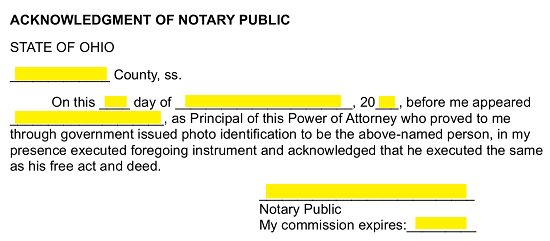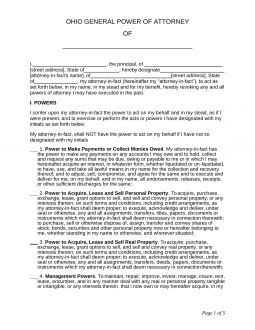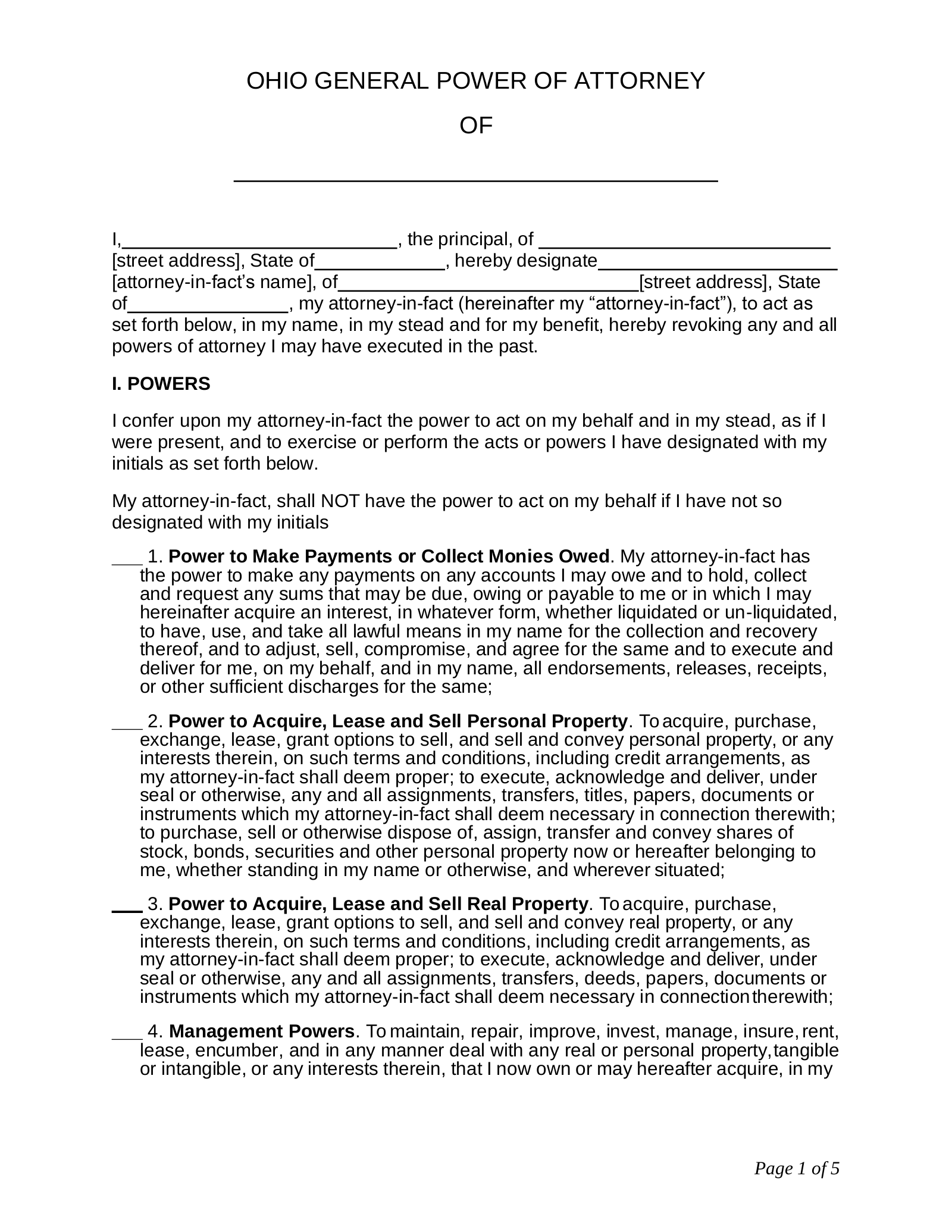Updated August 09, 2023
An Ohio general (financial) power of attorney form allows you to authorize a friend or relative to be your agent with regard to your financial affairs. Your agent will have the power to manage, make decisions, dispose and accumulate your assets and property, so it is imperative that you choose someone who will act in your best interest. This form is like the durable form except that it DOES NOT continue beyond the incapacity of the person who executes the document (the principal). If you are looking to have a financial POA in place while you are incapacitated, you should use the durable form instead.
Laws
- Statutes – Chapter 1337: Power Of Attorney
- Authority (R.C. § 1337.42) – An agent under a power of attorney may act on behalf of the principal and exercise broad authority as granted by the agreement.
- Signing Requirements (R.C. § 1337.25): The principal must have their signature acknowledged in the presence of a notary public.
How to Write
Download: PDF, MS Word, OpenDocument
1 – The Title And Introduction Demand Attention
The Title of this document, at the top of the first page, possesses a blank line after the words “Ohio General Power Of Attorney Of.” Fill in the Legal First, Middle, and Last Name of the Principal. This is the entity who will appoint the Power of his or her Authority to an Attorney-in-Fact through this document’s contents.
The paragraph immediately following the title will also have a few available spaces which must be satisfied with specific information. The first, second, and third available spaces of this paragraph call for the Principal’s Full Name, Residential Address, and State documented (respectively)  Similarly, the last three blank spaces of this paragraph require the Attorney-in-Fact’s Full Name, Residential Address, and State recorded in the respective area. This individual will be the person who will be empowered to act in the Principal’s affairs with Principal Authority
Similarly, the last three blank spaces of this paragraph require the Attorney-in-Fact’s Full Name, Residential Address, and State recorded in the respective area. This individual will be the person who will be empowered to act in the Principal’s affairs with Principal Authority
2 – A List Of Powers Requires The Principal’s Determinations And Approval
This document will furnish a list of Principal Powers for review. The Principal may approve the delegation one, a few, or all of these Powers to the Attorney-in-Fact but may only do so by initialing the corresponding blank line.
The first statement, “Power To Make Payments Or Collect Monies Owed,” supplies the wording the Principal may use to give the Attorney-in-Fact the Authority to perform such actions as pursuing or handling debts. If the Principal intends for the Attorney-in-Fact to have such Authority then, he or she must initial the blank line for this description. 
The Principal can use the second statement, “2. Power To Acquire, Lease And Sell Personal Property,” to enable the Attorney-in-Fact with the Principal Authority to conduct nearly any affairs (including buying, selling, renting) with the Principal’s Personal Property. The Principal should initial the blank line corresponding to this paragraph to grant this Power.  The third statement contains the wording to grant the Attorney-in-Fact the Principal Authority to wield “Power To Acquire, Lease And Sell Real Property” in the Principal’s Name. The Attorney-in-Fact will be able to engage in any of the activities described here if the Principal initials this statement.
The third statement contains the wording to grant the Attorney-in-Fact the Principal Authority to wield “Power To Acquire, Lease And Sell Real Property” in the Principal’s Name. The Attorney-in-Fact will be able to engage in any of the activities described here if the Principal initials this statement.  The Attorney-in-Fact will be able to represent the Principal’s interests by managing the property in his or her Name, once the Principal initials the paragraph with the label “4. Management Powers.”
The Attorney-in-Fact will be able to represent the Principal’s interests by managing the property in his or her Name, once the Principal initials the paragraph with the label “4. Management Powers.” If it’s been determined the Attorney-in-Fact should interact with Banks and other such Financial Institutions using the Principal’s Name and Authority, then the Principal will need to initial the “5. Banking Powers” paragraph.
If it’s been determined the Attorney-in-Fact should interact with Banks and other such Financial Institutions using the Principal’s Name and Authority, then the Principal will need to initial the “5. Banking Powers” paragraph.  The Principal can delegate the Principal Power to make decisions and take actions with his or her vehicles by initialing the statement “6. Motor Vehicles.”
The Principal can delegate the Principal Power to make decisions and take actions with his or her vehicles by initialing the statement “6. Motor Vehicles.” The wording in the seventh statement will enable to the Principal to give the Attorney-in-Fact the right to represent him or her with Tax Entities. If the Principal has determined the Attorney-in-Fact should wield this type of Principal Authority, then he or she should initial “7. Tax Powers.”
The wording in the seventh statement will enable to the Principal to give the Attorney-in-Fact the right to represent him or her with Tax Entities. If the Principal has determined the Attorney-in-Fact should wield this type of Principal Authority, then he or she should initial “7. Tax Powers.” 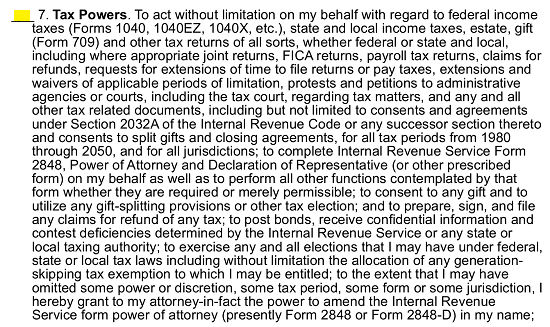
The Attorney-in-Fact can act with Principal Authority with his or her Safe-Deposit Boxes when the Principal initials the paragraph “8. Safe-Deposit Boxes.”
The Principal can empower the Attorney-in-Fact to engage in decisions regarding gifting through the act of initialing the statement labeled “9. Gift-Making Powers.”
The tenth statement will appoint the Attorney-in-Fact with the Principal Authority to engage in “Lending And Borrowing” activities on behalf of the Principal if the Principal initials the corresponding blank line.
The language supplied in the next statement allows the Principal to approve the Attorney-in-Fact’s use of Principal Authority regarding contractual agreements if he or she initials the line preceding the label “11. Contracts.”![]()
The ability to admit or discharge the Principal from Medical Facilities and to access his or her records can be assigned to the Principal Authority assigned to the Attorney-in-Fact through language in “12. Health Care.” The Principal must initial this item to have its contents apply to the Attorney-in-Fact’s Principal Powers.
The Principal can give the Attorney-in-Fact with the representational powers defined in the Health Insurance Portability Act of 1996 by initialing “13. HIPPA.”
In the fourteenth statement on this list, the Principal can deliver the “Power to Hire And Pay For Services.” If the Principal intends to delegate such Power to the Attorney-in-Fact, he or she should initial the blank space just before the number “14.”
If the Attorney-in-Fact should deliver Reimbursement to the Attorney-in-Fact as the Principal and with Principal Power, the Principal will have to initial “15. Reimbursement Of Attorney-in-Fact.”![]()
The wording supplied in “16. Power To Sue Third Parties Who Fail To Act Pursuant To Power Of Attorney” will allow the Attorney-in-Fact to enforce this Document’s Effect with Principal Authority. The Principal should initial this statement if the Attorney-in-Fact should wield such Principal Power.
The last label “17. Other” will supply an area where additional Powers may be granted to the Attorney-in-Fact. Make sure to be as specific as possible when naming additional Powers if this item is initialed by the Principal.
3 – The Principal Must Authorize This Appointment’s Effective Date And Termination Date
The Powers in this document can be delivered in one of two ways. They can either go into Effect immediately upon execution or only as of a certain date. Such matters will be addressed in “III. Effective Date And Termination.” To begin, the Principal must either initial the first statement to indicate these Powers go into effect upon execution or initial the second statement to name a specific date when they go into effect. If they are to go into effect upon a specific Date the Principal must fill in the Date, using the available blank lines. 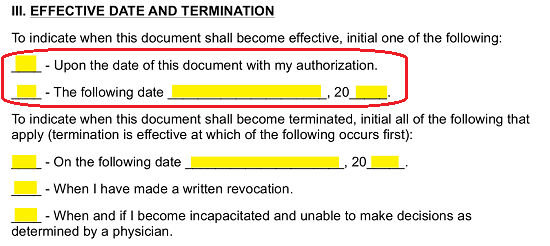 This section will also define how these Powers will Terminate or end. The Principal must choose then initial one of the last three statements to indicate his or her preference. If a specific date of Termination is required, then he or she should initial the “On The Following Date” statement and report the desired Date of Termination. The Principal may also choose to have these Powers Terminate only upon a Principal issued Revocation by marking the second statement in this area or Terminate when he or she is rendered incapacitated by initialing the last statement in this area.
This section will also define how these Powers will Terminate or end. The Principal must choose then initial one of the last three statements to indicate his or her preference. If a specific date of Termination is required, then he or she should initial the “On The Following Date” statement and report the desired Date of Termination. The Principal may also choose to have these Powers Terminate only upon a Principal issued Revocation by marking the second statement in this area or Terminate when he or she is rendered incapacitated by initialing the last statement in this area.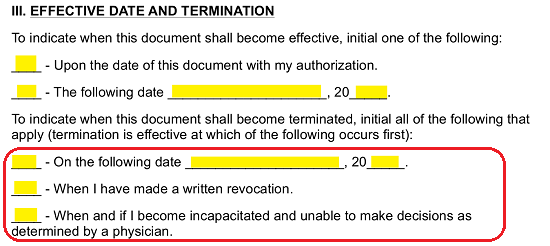
4 – The Signature Of The Principal Will Set This Document In Motion
This document can be executed by the Principal at his or her disposal, however, the Principal Signature must be accompanied by that of the Attorney-in-Fact and a Notary Public. The Principal will need to begin the execution process by filling in the Two-Digit Day of the Month, the Month Name, and the Year when he or she is signing this document on the first three blank lines in the “IV. Third Party Reliance” section.
The “Principal’s Signature” line must be signed by the Principal in the presence of a Notary Public. Below this, the Principal must print his or her Name. 
The “Acceptance Of Appointment” section will contain a statement where the Attorney-in-Fact’s Name must be printed. He or she should read this statement, then sign and print his or her name on the blank lines labeled “Attorney-in-Fact’s Signature” and “Attorney-in-Fact’s Printed Name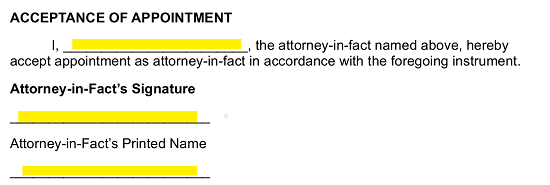
The final area will furnish the Notary Public with the structure necessary to notarize this document’s signing.